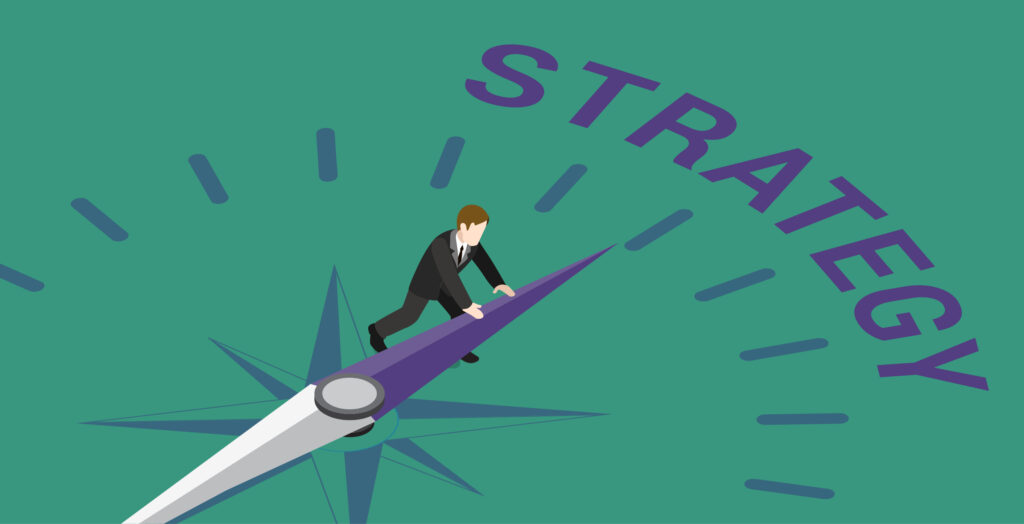
Focusing company strategy on customer value is a sine qua non of success.1 Companies’ sales, margins, and stock price all increase when their strategy is focused on the most critical strategic areas driving customer value. But to reap the rewards, executives must correctly identify the top two to three strategic areas for their firm.
Business-to-business executives pride themselves on staying in touch with customers through formal and informal listening.2 Stratonomics B2B™ discussions with executives at more than 50 small and medium B2B companies reveal that executives are confident they have correctly identified their companies’ top customer needs and they are using the right approach to strategy implementation.
Research shows their confidence is unfounded. A study of 17,251 customers of 127 publicly traded B2B companies shows that “the correlation between executives’ and customers’ [needs] rankings is negative or zero for 87.5% of companies and positive for only for 12.5% of companies.”3 The results have been validated among executives at dozens of B2B companies with annual sales of $5 million to $5 billion.
In each case, the correlation between customers’ and executives’ rankings of value drivers is zero. Objective evidence shows, B2B executives have a dismal track record of predicting strategic areas that create customer value.
When provided with evidence that their executives cannot correctly identify customer value drivers, CEOs react in three archetypical ways, each setting their company on a different strategic trajectory with different consequences.
• Archetype 1 – The Denier. About 60% of the CEOs display the Dunning–Kruger effect, overestimating their ability to understand customer needs and refusing to accept the science.
• Archetype 2 – The Commitment Escalator. About 30% of the CEOs acknowledge the science but continue escalating their commitment to legacy strategy. They stay put because of the experience trap, driven by egocentric decision making and confirmation bias.
• Archetype 3 – The Strategy-Centered CEO. Only 10% show humility, accept the science, have the curiosity to learn, and take the lead to implement a science-based strategy delivering top-notch customer value.
Archetype 1: The Denier
Classic deniers dismiss science, continue relying on salient beliefs, make intuitive leaps, and make “being right” a point of pride. They do this even as they reiterate their openness to embrace new ideas.
The CEOs manifest the classic Dunning–Kruger effect, remaining ignorant of their ignorance. Specifically, “poor performers…seem largely unaware of just how deficient their expertise is…Not only does their incomplete and misguided knowledge lead them to make mistakes, but those exact same deficits also prevent them from recognizing when they are making mistakes and choosing more wisely.”4
As an example, the CEO of one mid-market company was emphatic that he knew the top three drivers of customer value for his firm. “I am not sure if a science-based process will add much to our already vast industry knowledge and experience,” he emphasized.
The CEO offered two reasons for his belief. First, he personally talked to

customers on a regular basis. Second, he had hired two of his own customers in senior executive positions and talked to the customer-executives every day. “Not only do we know what our customers’ needs are, but we are fully aligned [with] those needs,” the CEO said with confidence.
As evidence of the assertion, the CEO and two former customers/senior executives wrote down the most critical customer needs that should drive the company’s strategy. All three predicted 100% overlap among their answers because they had been working so closely together. Their answers are shown in Table 1.

Stratonomics-B2B™ also analyzed the company’s website and sales materials to identify the value proposition communicated to customers.
Following are value statements excerpted from the website:
• Preventing problems and capturing opportunities.
• Expanding bandwidth and capabilities—instantly, seamlessly, and
on-demand.
• Offering deeply insightful, profoundly valuable, and tailored solutions
to your unique operating conditions.
Contrary to the CEO’s assertion, there was zero overlap among the three executives’ answers, and all three of them differed with the “value proposition” communicated by the company’s website and sales materials. When Stratonomics-B2B™ revealed the results to the CEO, he disputed the discrepancy, arguing that the executives’ collective
wisdom virtually ensured they were essentially correct and that the company’s strategy was not only customer-centered, but also on the right path.
CEOs in 30% of companies acknowledge the science and state they should follow it and improve their company’s strategic effectiveness. Yet, they remain committed to their legacy strategy.
University of Pennsylvania Wharton School psychologist Adam Grant, explaining President Biden’s commitment to running for a second term, wrote about the phenomenon of “escalation of commitment to a losing course of action” in a 2024 essay.5
“One of the tragedies of the human condition is that we use our big brains not to make rational decisions, but rather to rationalize the decisions we’ve already made,” Grant wrote.
As Grant explains, people are more likely to stay put when they feel emotionally attached to a plan or when they believe there is some chance—however slight—of succeeding.
The tendency is compounded in mid-market companies where CEOs are emotionally attached to their company’s legacy strategy because they believe in their own significant experience. Because of “the experience trap,” they are unwilling to change course.6
The CEO of a mid-market service company had grown the firm to about $10 million in sales, though management was dissatisfied with profitability. The company’s stated mission was “confidence and connections,” but employees remained confused about the motto’s meaning.
Customer research revealed they valued high-quality service, performed on time and without delays. But the company rated average to below average on the dimension.

Still, the CEO found excuses to stay put. He said the information was not “terribly new…we had known it all along—service is always important.” He also insisted, customers had been receiving high quality service because “we just met a customer for lunch who was gushing about our service.”
But the company had never systematically measured its service quality. When the firm started measuring it, it found it had fallen short of adequate service quality on more than 70% of contracts. Six months into monitoring the metric, the CEO was still resistant to change.
Another CEO agreed his company would benefit from a customer based strategy. Nonetheless, he too found reasons to stay put. He argued he intuitively knew his firm’s customer value drivers through his experience. When he saw the data showing he was likely wrong, he agreed but argued that he needed time to gain support from the company’s owner. He never raised the issue again.
CEOs at only 10% of companies are truly strategy centered. They embrace the scientific evidence, show the curiosity to understand it, have the humility to follow it, and display the courage to change course.
At one company, the executive team believed that customers valued competitive pricing, industry experience, and product quality. The notion was reinforced by the sales team’s experience with potential customers frequently mentioning competitive pricing and product quality in sales calls. Senior executives also believed that the company had a competitive advantage because it had been around for 30 years.
Research showed that the firm’s top two drivers of customer value were weekly status updates and timely issue resolution.
Instead of becoming trapped by the Dunning–Kruger effect or commitment escalation, the CEO accepted the science.
Working with his team, he began implementing a customer-based strategy based on the top drivers of customer value. Over time, sales grew 30% greater than competitors. More importantly, the change happened without any new hires and with a substantial margin increase.

The customer-focused strategy enabled employees to gain clarity about their daily work, spend more time than ever on customer relevant activities, eliminate wasteful initiatives, and increase interfunctional coordination.
Navigating company strategy is exciting and gives CEOs an opportunity to make an impact. It is also a heavy burden, as most CEOs—due to legacy strategy planning—believe they must continue to rely on their gut feel and instinct to set their firm’s strategy.
With ever-improving science, CEOs can substantially increase the value they create for customers, which impacts employees and shareholders. Other CEOs hold themselves and their company back because of the Dunning–Kruger effect or escalating commitment to a legacy strategy. Both are ego-protective mechanisms that may feel good to individual CEOs but ultimately harm companies.
It takes significant structured discussion and facilitation to recognize distortions in a CEO’s thinking, decision making, and actions. The process begins with the CEO fighting the internal battle necessary to become a strategy-centric executive.
Vikas Mittal, Ph.D., has published more than 100 articles on customer focused strategy and worked with senior executives at more than 200 organizations. He is the co-author of a 2021 book, FOCUS: How to Plan Strategy and Improve Execution to Achieve Growth, and a 2023 book, Market-Based Management, (7th edition).
Mittal, Vikas (2024), “Are You Navigating Strategy Correctly? Unveiling Three CEO Archetypes,” STRATONOMICS© Insight Series, September, 1–8.